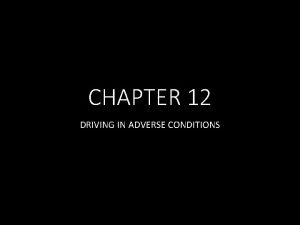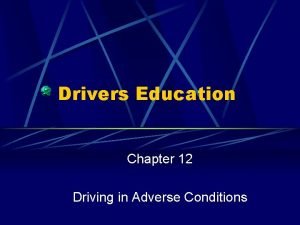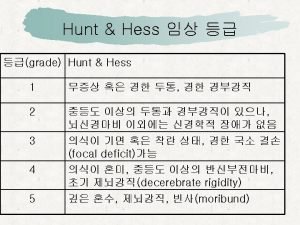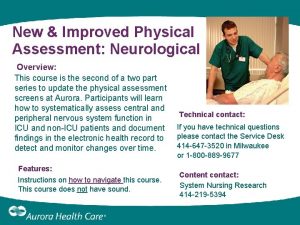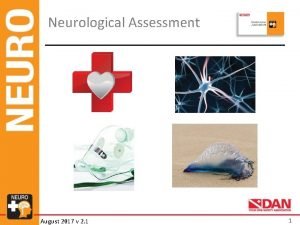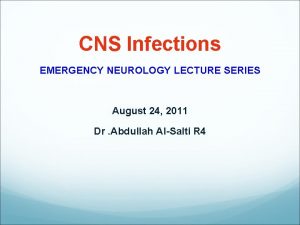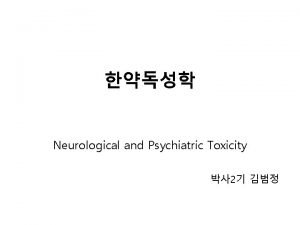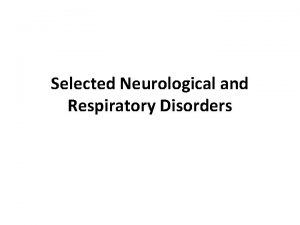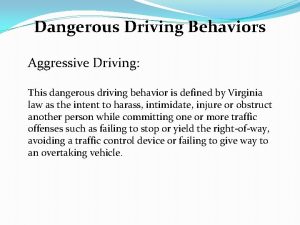Special Interest Group for Driving and Neurological Conditions











- Slides: 11

Special Interest Group for Driving and Neurological Conditions WFNR 2015

Why is this topic important? • Majority of adults are drivers, most younger people want to be drivers • A range of neurological conditions can adversely affect driving • Inconsistency of medical rules on fitness to drive in different countries, and within countries • Research has shown that many health professionals lack knowledge and are not good at advising patients on driving fitness • Limited number of effective reliable assessment and screening tools for different neurological conditions

Main Neurological Conditions Affecting Driving • • Brain injury Brain tumour Stroke Parkinson’s Epilepsy Dementia Spinal cord injury

Executive Committee • Chair: Dr Carol Hawley (UK) • Dr Shawn Marshall (Canada) • Dr Hannes Devos (Belgium/US)

Shawn Marshall (Canada) Ottawa Hospital Rehabilitation Centre Physician specialising in Physical Medicine and Rehabilitation • Research on medical aspects of fitness to drive • Impact of medical conditions and crash rates • Development of assessment tools for older drivers Hannes Devos (Belgium) Katholieke Universiteit Leuven; visiting Research Fellow at University of Iowa; Associate Director of Driving Simulation Laboratory; Assistant Professor at Georgia Regents University Physiotherapist • Assessment and rehabilitation of driving in people with neurological conditions • Screening tools

Aims • Principal Aim: To provide a resource for health professionals regarding safe driving among patients with a neurological condition. • Secondary Aims: • Collaborative research studies across different countries. • Examination/assessment and recommendation of screening tools • Contribute to the evidence on which medical rules for driving are based. • Deliver a position statement on driving after a neurological condition or event.

Current Objectives • To examine and compare methods of assessing driving fitness (including on and off road assessments) for neurological disorders. • To adopt a functional approach to assessment and management of fitness to drive. • To examine neurological disorders and driving accident risk in different countries and cultural settings. • To compare medical rules for driving across different countries and continents.

Desired Outcomes • Recommendations for good practice in assessing and screening patients who wish to start or return to driving • Attract members from a wide range of countries. • Work towards gaining funding for collaborative international research. • Publication of collaborative research papers.

Update • SIG meeting in Vienna (WFNR Congress 2010). • SIG meeting at WFNR Congress in Istanbul 2014. • Keynote speech on Driving at WFNR Congress in Istanbul, 2014 by Professor Shawn Marshall. • (Proposed Symposium not accepted for Istanbul congress) • Recent international study assessing the quality of guidelines on fitness to drive (Rapoport et al, 2015, QJM. in press).

Symposium at WFNR Congress, Philadelphia 2015 • Title: Medical Aspects of Fitness to Drive: How should we advise patients and how do we predict safe return to driving after neurological conditions? • • Chairs: Carol Hawley and Shawn Marshall Speakers: Shawn Marshall, Hannes Devos, Carol Hawley • • • Fitness to drive legislation Worldwide Guidelines for Fitness to Drive: A Review of Quality • • • Screening for fitness to drive Prediction of safe return to driving after brain injury or stroke: Which tools work best? Driving rehabilitation Patient perspectives on driving with a medical condition

Next Tasks • SIG meeting at WFNR Congress in Philadelphia 2016 • Proposed Symposium at WFNR, Philadelphia, 2016 • Increase membership • Develop newsletter • Develop links with other SIGs, e. g. Brain injury; Neurorehabilitation; Stroke rehab; Young WFNR
 Special driving conditions
Special driving conditions Chapter 12 driving in adverse conditions hidden message
Chapter 12 driving in adverse conditions hidden message Driving in adverse conditions chapter 12
Driving in adverse conditions chapter 12 Overdriving headlights means
Overdriving headlights means Driving in adverse conditions
Driving in adverse conditions What is real interest rate and nominal interest rate
What is real interest rate and nominal interest rate Simple interest and compound interest
Simple interest and compound interest Wfns score
Wfns score Pupil size chart
Pupil size chart Motor function neurological assessment
Motor function neurological assessment What is focal neurological signs
What is focal neurological signs Trapezium squeeze
Trapezium squeeze

